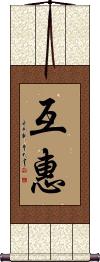Many custom options...
And formats...

Mutual Welfare in Chinese / Japanese...
Buy a Mutual Welfare calligraphy wall scroll here!
Personalize your custom “Mutual Welfare” project by clicking the button next to your favorite “Mutual Welfare” title below...
Mutual Welfare and Benefit
Jita-Kyoei
自他共栄 can be translated in a few different ways. Here are some possibilities:
Benefit mutually and prosper together.
Mutual welfare and benefit.
A learning concept of mutual benefit and welfare (that applies to all fields of society).
Mutual prosperity.
The first two characters are easy to explain. They are “self” and “others.” Together, these two characters create a word that means “mutual” (literally “me and them”).
The third character can have different meanings depending on context. Here, it means “in common” or “to share.”
The fourth character suggests the idea of “prosperity,” “flourishing,” or becoming “glorious.”
It should be noted that these Kanji are used almost exclusively in the context of Judo martial arts. 自他共榮 is not a common or recognized Japanese proverb outside of Judo.
You may see this romanized as Jita-Kyoei or Jitakyoei.
In modern Japanese Kanji, the last character looks like ![]() instead of
instead of ![]() . If you want the older/traditional version, please let us know when you place your order.
. If you want the older/traditional version, please let us know when you place your order.
Mutual Benefit
This word means mutual benefit or mutually beneficial in Chinese, Japanese Kanji, and old Korean Hanja.
This can also be defined as reciprocity or reciprocal.
Note: In Japanese, they will tend to drop one stroke on the second character and write 互恵 instead of 互惠. If this small variation matters to you, please drop me a note when you place your order.
Seiryoku Zenyo
精力善用 means “maximum efficiency” and is often associated with Judo.
It is often matched with “Jita Kyoei” (mutual benefit) to complete the philosophy of Kodokan Judo.
精力 = sei ryoku = energy, vigor, and/or vitality.
善用 = zen yo = to be good at using (something), or to put (something) to good use.
Not the results for mutual welfare that you were looking for?
Below are some entries from our dictionary that may match your mutual welfare search...
| Characters If shown, 2nd row is Simp. Chinese |
Pronunciation Romanization |
Simple Dictionary Definition |
互惠 see styles |
hù huì hu4 hui4 hu hui |
More info & calligraphy: Mutual Benefit |
互恵 see styles |
gokei / goke ごけい |
reciprocity; mutual benefit |
兼利 see styles |
jiān lì jian1 li4 chien li kanetoshi かねとし |
(s,m) Kanetoshi Mutual benefit; to benefit self and others. |
共同利益 see styles |
gòng tóng lì yì gong4 tong2 li4 yi4 kung t`ung li i kung tung li i |
common interest; mutual benefit |
共済組合 see styles |
kyousaikumiai / kyosaikumiai きょうさいくみあい |
cooperative society; mutual-benefit association |
平等互利 see styles |
píng děng hù lì ping2 deng3 hu4 li4 p`ing teng hu li ping teng hu li |
mutual benefit; to share profits equitably |
集思廣益 集思广益 see styles |
jí sī guǎng yì ji2 si1 guang3 yi4 chi ssu kuang i |
collecting opinions is of wide benefit (idiom); to pool wisdom for mutual benefit; to profit from widespread suggestions |
The following table may be helpful for those studying Chinese or Japanese...
| Title | Characters | Romaji (Romanized Japanese) | Various forms of Romanized Chinese | |
| Mutual Welfare and Benefit | 自他共榮 自他共荣 / 自他共栄 | ji ta kyou ei jitakyouei ji ta kyo ei | ||
| Mutual Benefit | 互惠 | gokei | hù huì / hu4 hui4 / hu hui / huhui | |
| Seiryoku Zenyo | 精力善用 | sei ryoku zen yo seiryokuzenyo | ||
| In some entries above you will see that characters have different versions above and below a line. In these cases, the characters above the line are Traditional Chinese, while the ones below are Simplified Chinese. | ||||
Successful Chinese Character and Japanese Kanji calligraphy searches within the last few hours...






